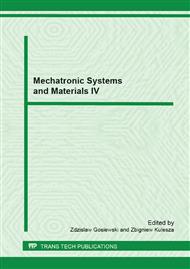p.451
p.457
p.467
p.473
p.483
p.489
p.495
p.501
p.507
Energy Dissipation of Synchronized Switch Damping with Piezoceramics Using Negative Capacitance
Abstract:
This publication presents a novel piezoelectric shunt damping circuit. It consists of a negative capacitance in parallel to a synchronized switch damping on inductor (SSDI) branch. This combination utilizes the increased piezoelectric coupling due to the negative capacitance together with the adaptive ability of the SSDI technique. This novel circuit is theoretically modelled using non-dimensional parameters, and optimum network parameters and the corresponding maximum damping is obtained. The increase in damping performance due to the negative capacitance is clearly highlighted. Theoretically, the energy dissipation can be increased unlimited when tuning the system at the stability boundary, given the system would still be excited to vibrations. However, due to imperfections and practical realization using operational amplifiers the increase is limited.
Info:
Periodical:
Pages:
483-488
Citation:
Online since:
March 2013
Authors:
Price:
Сopyright:
© 2013 Trans Tech Publications Ltd. All Rights Reserved
Share:
Citation:


